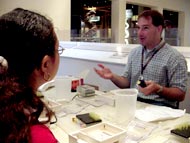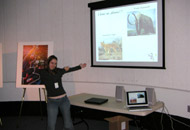Stanford at The Tech
Are you a grad student or post-doc within any biology oriented department at Stanford?
Ever wish that ...
- reporters and movies would get the science right?
- the public wasn't scared of science?
- you could tell your grandma what you do in the lab?
Here's your chance to make those wishes come true!
The Stanford Department of Genetics offers graduate students and post-docs in any biology department the chance to work at The Tech Museum of Innovation (The Tech) for one morning/week for two quarters. You'll get on the job training in presenting science to the public in person and in writing.
Things you'll do at The Tech:
- Running floor programs: Guide visitors through activities like spooling DNA from calf thymus and running agarose gels. Use your expertise to answer their questions about genetics.
- Write for the web: Contribute to The Tech's online exhibit, Understanding Genetics, by answering questions at Ask a Geneticist and providing articles on current hot topics in genetics to Genetics in the News.
- Final project: In your second quarter, you'll take everything you've learned and work on developing a "final project" of your own. These final projects can be new programs for the exhibit floor, something new for the web, or even additions to the exhibition.
- Other activities: You can also help teach classes, give talks, prototype new programs and exhibits, update the floor exhibition or anything else useful you can dream up.
About the Program

The program is part of an ongoing collaboration between the Stanford Department of Genetics and The Tech Museum of Innovation. Together these two partners created the Genetics: Technology with a Twist exhibition.

Stanford graduate students and post-docs like you serve a critical role in the success of the exhibition. You'll provide your expertise in answering guests' questions both at the museum and on the web. In addition, you'll help out at the most popular part of the exhibit by providing the raw materials for the Wet Lab.
At the museum, you'll run floor programs like DNA spooling and Biotech Tool Time (running Kool Aid dyes on agarose gels). On the web, you'll write answers to people's questions at "Ask a Geneticist" as well as contribute articles on what's hot in genetics right now at "Genetics in the News." At the end, you'll create and/or implement a final project that will live on at The Tech after you've gone.
Program Specifics

- You must be a graduate student or post-doc at Stanford. It is not necessary to be part of the Department of Genetics.
- A commitment of 4-6 hours/week for 2 quarters is required. Generally, 2-3 hours/week are at The Tech with the rest of the time spent researching and writing for the web features, Ask a Geneticist and Current News in Genetics, at Stanford.
- Sometime during the 2 quarters, you will need to provide two maxipreps of a provided plasmid and competent E. coli cells from a 2 liter culture. This keeps The Tech's wet lab running. It takes about 4-6 hours and is often done in lieu of coming to The Tech one week.
- While not required, most participants work on a final project in their second quarter. They can either come up with something new or help along a previous participant's project.
- A stipend is provided for your time. The stipend is equivalent to helping to teach a class for one quarter in the department of genetics spread out over 2 quarters. In other words, you get half of the usual stipend during each of your two quarters.

If you are interested in being part of this program, please email Barry Starr to find out more information about how to get started.
Current Participants -- Fall 2014 & Winter 2015

|
Grad Student, Developmental Biology Minx Fuller Lab Research interest: Adult Stem Cell Microenvironment |

|
Grad Student, Biochemistry Pehr Harbury Lab Research interest: Conformational Change in Molecular Machines |

|
Grad Student, Biology Martin Jonikas Lab Research interest: Carbon acquisition in algal photosynthesis |

|
Grad Student, Genetics Billy Li Lab Research Interest: Regulation of mRNA Processing |

|
Grad Student, Genetics David Kingsley Lab Research interest: Molecular basis of vertebrate evolution |
Learn more about the participants.
This project was supported by a Science Education Partnership Award (SEPA) from the National Center For Research Resources, National Institutes of Health. Its content is solely the responsibility of the authors and does not necessarily represent the official views of NCRR or NIH.

